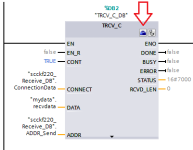larsjohan85
Member
Hi all experts!
I'm having a bit trouble with UDP communication with a CPU 1512SP-1 PN and a Kongsberg Seatex MRU 3.
The MRU is set to output values in a UDP broadcast packet, IP address 192.168.0.20, subnet 255.255.255.0.
PLC is set to ip 192.168.0.10, subnet 255.255.255.0.
A connection is set up for the MRU, local ID 0x100, Partner is set to "(All broadcast devices)" and connection type is set to UDP connection.
Program consists of a single network in OB1 with a TRCV_C FB with a separate instance DB. All inputs and outputs are to a DB (Params) for easy troubleshooting.
Is there something i have overlooked in the configuration? I get error 0x809B "InterfaceID is invalid".
Repository: https://github.com/larsjohan85/S7-1500_MRU






Kind regards
Lars Lone
I'm having a bit trouble with UDP communication with a CPU 1512SP-1 PN and a Kongsberg Seatex MRU 3.
The MRU is set to output values in a UDP broadcast packet, IP address 192.168.0.20, subnet 255.255.255.0.
PLC is set to ip 192.168.0.10, subnet 255.255.255.0.
A connection is set up for the MRU, local ID 0x100, Partner is set to "(All broadcast devices)" and connection type is set to UDP connection.
Program consists of a single network in OB1 with a TRCV_C FB with a separate instance DB. All inputs and outputs are to a DB (Params) for easy troubleshooting.
Is there something i have overlooked in the configuration? I get error 0x809B "InterfaceID is invalid".
Repository: https://github.com/larsjohan85/S7-1500_MRU
Kind regards
Lars Lone




